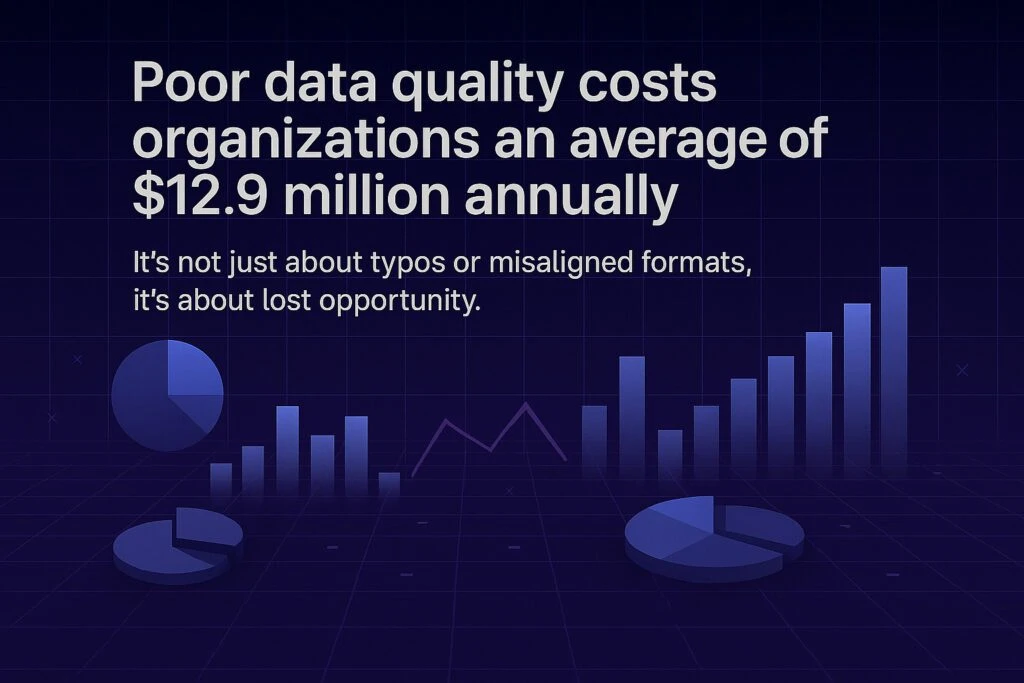In today’s AI-powered world, enterprises strive for intelligent automation. Quantum computing and AI are reshaping today’s enterprise landscape—powering intelligent automation, predictive insights, and real-time decisions. Yet one silent obstacle continues to challenge AI performance: poor data quality. Incomplete maintenance logs, inconsistent asset records, and siloed information still plague digital systems.
At the root of the issue is a fundamental mismatch—traditional computing struggles to efficiently process unstructured, fragmented, and high-volume data. Enter quantum computing, a game-changing paradigm poised to transform how we manage, clean, and harness messy data.
The Hidden Cost of Bad Data
According to IBM, poor data quality costs organizations an average of $12.9 million annually. It’s not just about typos or misaligned formats—it’s about lost opportunity.
Take a typical industrial scenario: predictive maintenance in manufacturing. AI algorithms are tasked with anticipating machine failures using historical data, logs, temperature readings, part replacements, and operator notes. But these records are often:
- Incomplete (missing fields or timestamps)
- Inconsistent (different naming conventions)
- Unstructured (handwritten technician notes)
- Underutilized (stored in silos, never analyzed)

Quantum Computing—A Paradigm Shift
Quantum computing is not just a faster processor; it’s an entirely new computational framework. Leveraging principles like superposition and entanglement in computing, quantum machines can process countless possibilities simultaneously.
Imagine trying to find the best maintenance schedule across thousands of machines, each with unique usage patterns, part wear, and environmental conditions. A classical system must evaluate each scenario one at a time. A quantum AI data processing system can evaluate all combinations at once, uncovering hidden correlations, anomalies, and optimizations with unprecedented speed.
What is Quantum Computing?
Quantum computing is a revolutionary approach that leverages the principles of quantum mechanics to process information at unimaginable speed and scale. Unlike traditional computers that use bits (0s and 1s), quantum computers use qubits, which can represent multiple states simultaneously. This allows quantum systems to solve complex problems—like molecular modeling, financial simulations, and AI training—in minutes instead of years.
As industries seek breakthroughs in performance, security, and efficiency, quantum computing and AI are poised to redefine what’s possible in data processing. At Prolifics, we’re closely tracking this evolution to help businesses prepare for the quantum-powered future.
Practical Applications of Quantum Computing
Here’s how quantum computing is reshaping the industries:
- Drug Discovery & Life Sciences: Simulate molecular interactions to accelerate the development of new treatments and vaccines.
- Finance & Risk Management: Analyze massive datasets to detect fraud, model financial risks, and optimize portfolios with unmatched precision.
- Supply Chain & Logistics: Solve complex routing, scheduling, and inventory optimization problems in real time.
- Cybersecurity: Advance cryptography and prepare for the post-quantum world with new algorithms resistant to quantum attacks.
- Energy & Materials: Design better batteries, superconductors, and sustainable energy solutions by modeling atomic-level interactions.
Key Advantages for Data Processing
- Parallelism at Scale: Quantum systems evaluate multiple data states at once, ideal for analyzing incomplete or noisy data.
- Enhanced Pattern Recognition: Quantum algorithms can detect subtle correlations lost in traditional computations.
- Efficient Search and Optimization: Quantum search algorithms (like Grover’s) drastically reduce the time needed to sift through vast datasets.
- Natural Fit for Probabilistic AI Models: Quantum’s probabilistic nature aligns well with how modern AI models (especially generative AI) process and infer data.
Quantum + AI = Synergistic Power
Quantum computing’s greatest promise lies in algorithmic synergy with AI. Together, they can tackle some of the biggest limitations in today’s data landscape:

- Data Cleaning at Quantum Speed
Quantum-enhanced machine learning models can identify outliers, impute missing values, and normalize data in milliseconds, especially useful for non-standard datasets like equipment diagnostics or technician notes. - Unstructured Data Conversion
Quantum natural language processing (QNLP) techniques are being explored to transform unstructured maintenance logs into structured datasets that AI can learn from. - Accelerated Feature Selection
Quantum algorithms can quickly isolate the most predictive variables from large data lakes, helping models focus on what truly matters for performance. - Smarter Predictions in Noisy Environments
When data is messy, AI often outputs poor results. Quantum-enhanced models can handle higher uncertainty and improve model robustness in chaotic, real-world conditions.
Real-World Impact: Smarter Maintenance, Safer Operations
With quantum + AI, organizations can:
- Predict part failures even when historical records are incomplete
- Correlate sensor anomalies with technician reports instantly
- Generate accurate maintenance schedules that adapt in real time
- Reduce manual review efforts by automating noisy-data processing
The Path Forward: Prepare Now
While fully mature quantum computers are still in development, hybrid quantum classical AI models are already making headway. Tech giants like IBM and Google have introduced cloud-based quantum simulators and early-stage hardware. Companies like Sigma Computing are investing in quantum data infrastructure to bridge the gap.
At Prolifics, we’re building future-proof data ecosystems that anticipate this shift. Our modern data platforms are designed to integrate with evolving quantum capabilities, ensuring clients are not just ready for tomorrow but are leading it.
Here’s how you can get started:
- Conduct a Data Quality Audit: Identify messy or underused data that limits AI performance (think maintenance logs, forms, PDFs).
- Modernize Your Architecture: Move toward modular, cloud-native architecture for quantum AI that can support quantum-enhanced workloads.
- Integrate Smart Governance: Use metadata-driven data frameworks (e.g., Manta, Microsoft Purview) to ensure your data is traceable and secure.
- Explore Hybrid AI Models: Work with partners who understand both AI and quantum to begin pilot projects.
Conclusion: The Power of One, Data, Quantum, AI
We’re on the edge of a breakthrough. Quantum computing for data management is set to redefine what’s possible in AI data quality solutions and performance. But it starts with cleaning house—fixing the fragmented, incomplete, and unstructured data hiding across your enterprise.
At Prolifics, we bring together the power of one—a unified approach to enterprise AI transformation strategies, data modernization, and emerging tech readiness. From exploratory audits to quantum-ready architecture, we help businesses go from idea to impact faster.




